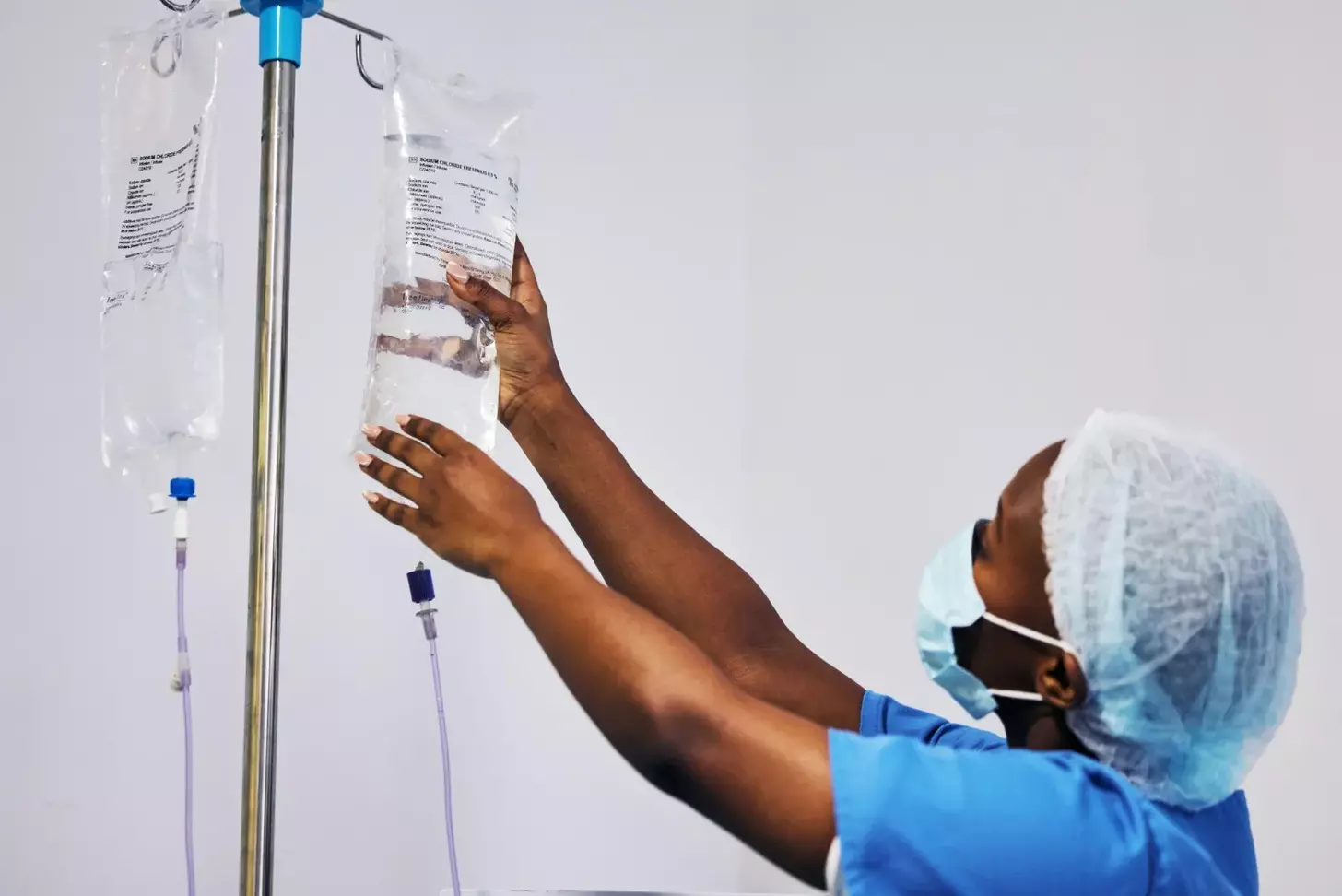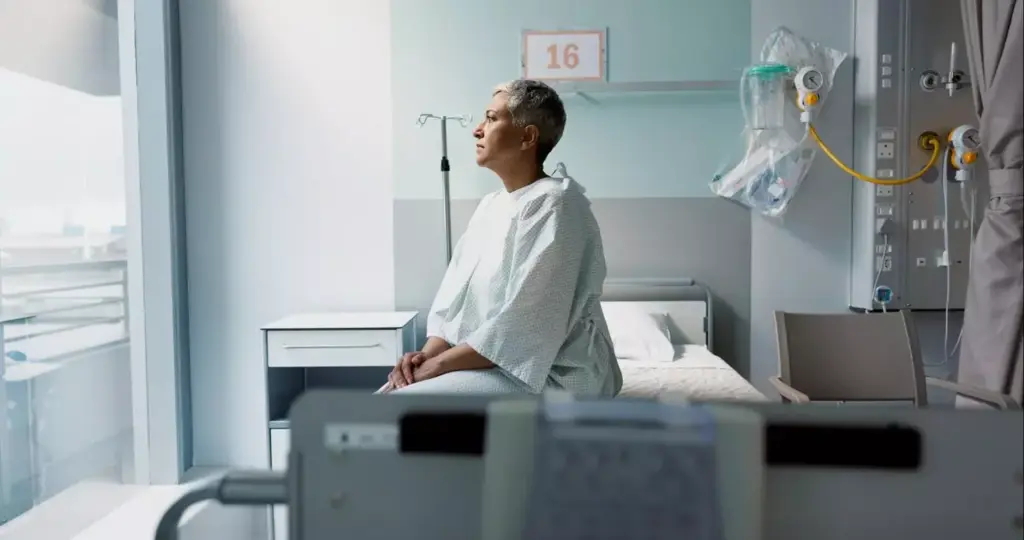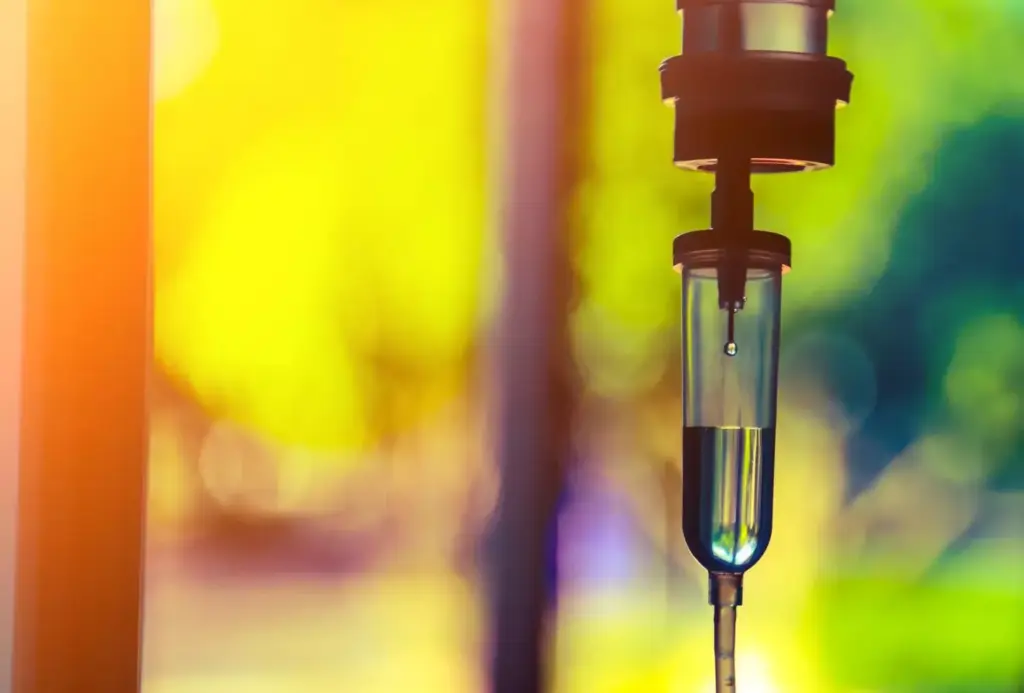Last Updated on November 26, 2025 by Bilal Hasdemir

At Liv Hospital, we understand the importance of effective cancer treatment methods. Chemo infusion, or IV chemotherapy drip, is a widely used method for delivering cancer drugs directly into the bloodstream through a vein. This approach allows for rapid distribution of the drugs throughout the body, making it an effective treatment for various types of cancer.
Cancer patients, like Clea Shearer, face numerous challenges during treatment. Understanding how chemo infusion works can help patients navigate their treatment options and trust the expertise provided by institutions like Liv Hospital. For more information on what to expect during treatment, you can learn about the typical number of chemotherapy rounds.
Key Takeaways
- Chemo infusion delivers cancer drugs directly into the bloodstream.
- This method allows for rapid distribution of drugs throughout the body.
- It’s an effective treatment for various types of cancer.
- Understanding chemo infusion can help patients navigate treatment options.
- Liv Hospital provides expert care and support for cancer patients.
Understanding Chemo Infusion Therapy
Chemo infusion therapy represents a significant advancement in the fight against cancer, providing targeted and effective treatment options. As we continue to evolve in our understanding and treatment of cancer, chemo infusion remains a cornerstone in the arsenal against this complex disease.
Definition and Basic Principles
Chemo infusion therapy involves the intravenous administration of chemotherapy drugs directly into the bloodstream. This method allows for the systemic distribution of therapeutic agents, targeting cancer cells throughout the body. The basic principle behind chemo infusion is to deliver high concentrations of chemotherapy drugs directly to the cancer cells while minimizing exposure to healthy tissues.
By using an intravenous (IV) line, healthcare providers can ensure that the chemotherapy drugs are delivered effectively and safely. This approach enables the treatment of various types of cancers that have spread or are at risk of spreading to other parts of the body.
Role in Modern Cancer Treatment
In modern cancer treatment, chemo infusion therapy plays a vital role in managing various types of cancers. It is often used in conjunction with other treatment modalities such as surgery, radiation therapy, and immunotherapy. The flexibility of chemo infusion allows it to be tailored to the individual needs of each patient, making it a versatile treatment option.
We utilize chemo infusion therapy in a variety of clinical scenarios, including:
- As a primary treatment to shrink tumors before surgery or radiation
- As an adjuvant treatment to eliminate any remaining cancer cells after surgery
- As a palliative measure to alleviate symptoms in advanced cancer
Types of Cancers Commonly Treated with Infusion
Chemo infusion therapy is used to treat a wide range of cancers. Some of the most common types include:
| Type of Cancer | Description | Common Chemo Infusion Drugs |
|---|---|---|
| Breast Cancer | Cancer that begins in the breast tissue | Doxorubicin, Paclitaxel |
| Lymphoma | Cancer of the lymphatic system | Rituximab, Cyclophosphamide |
| Leukemia | Cancer of the blood and bone marrow | Cytarabine, Daunorubicin |
The story of Mary Davis Rutledge, a young girl who thrived after receiving cancer treatment, is a testament to the positive outcomes that can be achieved with effective chemo infusion therapy. Her journey highlights the importance of this treatment method and its potential to improve the lives of cancer patients.
The Science Behind Chemotherapy IV Drip
The intravenous administration of chemotherapy drugs represents a significant advancement in oncology, offering a targeted approach to combating cancer. This method has revolutionized the treatment of various malignancies, providing a direct and effective way to deliver therapeutic agents to cancer cells.
How Chemotherapy Drugs Target Cancer Cells
Chemotherapy drugs administered through an IV drip are designed to target rapidly dividing cells, a characteristic of most cancer cells. “Chemotherapy is most effective against cancers that have a high growth fraction, meaning they are rapidly dividing.” These drugs work by interfering with the cell division process, thereby inhibiting the growth and proliferation of cancer cells. The precise mechanism of action varies depending on the specific chemotherapy agent used.
For instance, some chemotherapy drugs, such as anthracyclines, intercalate DNA strands, preventing the replication of genetic material. Others, like taxanes, stabilize microtubules, essential for cell division, thereby halting the cell cycle. This targeted approach allows for the effective treatment of various cancers, including breast cancer, as seen in the case of patients like Cameron Byman, who was diagnosed with stage 4 breast cancer.
Benefits of Intravenous Administration
Administering chemotherapy through an IV drip offers several benefits. Firstly, it allows for the rapid distribution of drugs throughout the body, ensuring that cancer cells are targeted systemically. “Intravenous administration ensures high bioavailability of chemotherapy drugs.” This is particularly important for cancers that have metastasized or are at risk of spreading.
- Ensures high bioavailability of the drug
- Allows for precise control over dosage
- Enables the administration of high doses when necessary
Rapid Systemic Distribution in the Body
When chemotherapy drugs are administered intravenously, they are quickly dispersed throughout the body via the bloodstream. This rapid distribution is crucial for targeting cancer cells that may have spread to different parts of the body.
The quick action of IV chemotherapy helps in managing symptoms and slowing disease progression. It’s an essential aspect of treatment for many cancer patients, offering a potent tool in the fight against cancer.
“The ability to deliver chemotherapy directly into the bloodstream has been a game-changer in cancer treatment, providing a powerful means to target cancer cells throughout the body.”
In conclusion, the science behind chemotherapy IV drip is rooted in its ability to effectively target cancer cells through intravenous administration. By understanding how these drugs work and the benefits they offer, patients can better appreciate the role of chemotherapy infusion therapy in their treatment journey.
Preparing for Your First Chemotherapy IV Drip Session
Preparing for your first chemotherapy IV infusion involves several important steps that can help you feel more confident and in control. As you begin this significant treatment journey, understanding what to expect can make a substantial difference in your overall experience.
Medical Evaluations and Tests
Before your first chemotherapy IV drip session, we conduct a series of medical evaluations and tests to ensure that you’re ready for the treatment. These assessments help us understand your overall health and determine the most appropriate chemotherapy regimen for your specific needs.
Some of the tests you may undergo include blood work, imaging studies, and other diagnostic procedures. These evaluations are crucial in helping us tailor the treatment to your individual condition and monitor your progress throughout the therapy.
Patient Education and Counseling
Patient education is a vital component of preparing for chemo IV treatment. Our team will provide you with comprehensive information about what to expect during the infusion process, potential side effects, and how to manage them effectively.
We also offer counseling services to support you emotionally and psychologically as you navigate this challenging time. Our goal is to empower you with the knowledge and resources needed to make informed decisions about your care.
Practical Preparations for Infusion Day
On the day of your first IV therapy for cancer session, there are several practical steps you can take to prepare. We recommend that you:
- Wear comfortable, loose-fitting clothing to make the infusion process easier.
- Bring any necessary documents, such as insurance information and identification.
- Have a friend or family member accompany you for support.
- Stay hydrated and eat a light meal before your appointment.
By being well-prepared, you can help ensure that your first chemotherapy IV drip session goes as smoothly as possible.
The IV Chemotherapy Administration Process
As a patient prepares for their first chemotherapy IV drip session, understanding the administration process can alleviate anxiety. We guide our patients through every step, ensuring they feel informed and comfortable throughout their treatment journey.
Pre-Infusion Preparation and Assessment
Before the chemotherapy infusion begins, we conduct a thorough assessment to ensure the patient’s overall health is suitable for the treatment. This includes reviewing medical history, current health status, and any previous reactions to chemotherapy. Our medical team also explains the procedure, potential side effects, and answers any questions the patient may have, providing emotional support and reassurance.
A recent case of a patient diagnosed with stage 4 melanoma lung cancer highlights the importance of thorough pre-infusion preparation. The patient’s initial anxiety was significantly reduced after our team explained the chemotherapy administration process, helping them feel more in control of their treatment.
What Happens During the Infusion Session
During the IV chemotherapy administration, the patient is seated comfortably in a designated infusion area. Our trained nurses insert a sterile needle into a vein, usually in the arm, and secure it with tape. The chemotherapy drugs are then administered through this IV line, which is connected to an infusion pump that controls the rate of drug delivery.
The duration of the infusion session varies depending on the type of chemotherapy and the patient’s specific treatment plan. Throughout the session, our medical staff monitor the patient’s vital signs and watch for any signs of adverse reactions, ensuring a safe and effective treatment.
Post-Infusion Monitoring and Care
After the chemotherapy infusion is complete, we continue to monitor the patient’s condition for a period to ensure there are no immediate adverse reactions. Our team provides instructions on post-infusion care, including managing potential side effects and maintaining the integrity of the IV site.
We emphasize the importance of follow-up appointments to monitor the patient’s response to the treatment and adjust the care plan as necessary. By providing comprehensive support throughout the chemotherapy process, we help our patients navigate their treatment journey with confidence.
Venous Access Devices for Chemotherapy Delivery
For cancer patients undergoing chemotherapy, the right venous access device can make a significant difference in their treatment journey. We understand that effective venous access is crucial for administering chemotherapy safely and efficiently.
Peripheral IV Catheters
Peripheral IV catheters are commonly used for short-term chemotherapy administration. They are typically placed in a vein in the arm and allow for the delivery of chemotherapy drugs directly into the bloodstream. While they are suitable for initial treatments, their use is limited for longer treatment durations due to the risk of complications such as phlebitis.
Central Venous Catheters (CVC)
Central Venous Catheters (CVC) offer a more durable solution for patients requiring prolonged chemotherapy. These catheters are inserted into a larger vein, usually in the neck or chest, providing a more stable access point for chemotherapy administration. CVCs reduce the risk of certain complications associated with peripheral IVs and are particularly useful for patients who require high-volume or long-term treatment.
PICC Lines for Extended Treatment
PICC (Peripherally Inserted Central Catheter) lines are a type of CVC that is inserted through a vein in the arm and guided to a larger vein near the heart. PICC lines are ideal for extended treatment periods, as they can remain in place for several months. They offer the advantage of reducing the need for repeated venipunctures and are associated with a lower risk of certain complications compared to other central lines.
Implantable Ports for Long-Term Therapy
Implantable ports are another type of venous access device used for long-term chemotherapy. These devices are surgically implanted under the skin and consist of a reservoir that is connected to a catheter placed in a large vein. Implantable ports are particularly advantageous for patients undergoing prolonged treatment, as they provide a secure and stable access point that is less prone to infection and other complications.
Each of these venous access devices has its own set of benefits and is suited to different patient needs and treatment regimens. By understanding the options available, healthcare providers can make informed decisions that enhance patient care and treatment outcomes.
Continuous vs. Intermittent Chemotherapy IV Drip Protocols
The effectiveness of chemotherapy IV drip protocols hinges on whether a continuous or intermittent infusion approach is used. We will explore the differences between these two methods and their implications for cancer treatment.
Single-Day Infusion Sessions
Single-day infusion sessions involve administering chemotherapy drugs over a short period, typically within 24 hours. This approach is often used for patients with certain types of cancer, such as breast cancer or lymphoma. The benefits of single-day infusions include reduced hospital stay and faster recovery time. However, this method may not be suitable for all patients, particularly those requiring prolonged exposure to chemotherapy agents.
Multi-Day Continuous Infusions
Multi-day continuous infusions, on the other hand, involve administering chemotherapy over several days. This approach allows for prolonged exposure to the chemotherapy agents, which can be beneficial for certain types of cancer. We have found that multi-day infusions are particularly effective for tumors that are sensitive to prolonged chemotherapy exposure. However, this method requires careful monitoring and management of potential side effects.
Determining the Optimal Approach for Different Cancers
Determining the optimal chemotherapy IV drip protocol depends on various factors, including the type and stage of cancer, patient health, and treatment goals. We consider several factors when deciding between continuous and intermittent infusion methods. For example, patients with aggressive tumors may benefit from more intensive, continuous infusion protocols, while those with slower-growing tumors may be suitable for intermittent infusions.
Ultimately, the choice between continuous and intermittent chemotherapy IV drip protocols requires a personalized approach, taking into account the unique needs and circumstances of each patient. By carefully evaluating the benefits and limitations of each method, we can provide effective cancer treatment that improves patient outcomes.
Managing Side Effects and Complications of IV Chemotherapy
Effective management of IV chemotherapy side effects is essential for improving patient outcomes and quality of life. As we’ve discussed in previous sections, IV chemotherapy is a critical component of cancer treatment, but it can lead to various complications that need to be addressed promptly and effectively.
Immediate Reactions at the Infusion Site
One of the common issues associated with IV chemotherapy is immediate reactions at the infusion site. These can include:
- Redness and swelling
- Pain or discomfort
- Phlebitis (inflammation of the vein)
To manage these reactions, healthcare providers often use techniques such as applying cold compresses or administering medications to reduce inflammation. In some cases, adjusting the infusion rate or using a different venous access device may be necessary.
Systemic Side Effects and Their Management
Systemic side effects of IV chemotherapy can be more widespread, affecting various bodily systems. Common systemic side effects include:
- Nausea and vomiting
- Fatigue
- Hair loss
- Bone marrow suppression
Managing these side effects often requires a multi-faceted approach, including:
- Antiemetic medications for nausea and vomiting
- Growth factors to support bone marrow function
- Personalized counseling and support for coping with fatigue and other symptoms
Supportive Care During Treatment Cycles
Supportive care plays a vital role in helping patients navigate the challenges of IV chemotherapy. This includes:
- Nutritional counseling to maintain strength and manage dietary side effects
- Psychological support through counseling or support groups
- Monitoring and managing potential long-term effects of treatment
By providing comprehensive supportive care, healthcare teams can help patients better tolerate treatment and maintain their quality of life throughout the chemotherapy process.
As highlighted by patients like Clea Shearer, who have experienced complications during treatment, the importance of managing side effects effectively cannot be overstated. By understanding the potential side effects of IV chemotherapy and implementing strategies to mitigate them, healthcare providers can significantly improve patient outcomes.
Advanced Approaches in Cancer Infusion Therapy at Specialized Centers
Liv Hospital is at the forefront of cancer infusion therapy, offering precision and innovation. We recognize that every patient’s journey with cancer is unique, and our approach to infusion therapy reflects this understanding.
Precision Dosing Technologies at Liv Hospital
At Liv Hospital, we utilize advanced precision dosing technologies to ensure that patients receive the most effective dose of chemotherapy. This approach minimizes side effects while maximizing the therapeutic impact. Our state-of-the-art equipment allows for real-time monitoring and adjustments, providing a tailored treatment plan for each patient.
Innovative Combination Therapies
We are committed to staying at the forefront of cancer research and treatment. Our oncologists work collaboratively to develop innovative combination therapies that address the complex nature of various cancers. By combining different treatment modalities, we can target cancer cells more effectively, improving patient outcomes.
State-of-the-Art Infusion Centers and Patient Experience
Our infusion centers are designed to provide a comfortable and supportive environment for patients undergoing cancer infusion therapy. With state-of-the-art facilities, we ensure that patients receive their treatments in a setting that promotes relaxation and well-being. Our dedicated staff are trained to provide compassionate care, addressing the physical and emotional needs of our patients.
Liv Hospital’s Approach to Quality Cancer Care
At Liv Hospital, our commitment to quality cancer care is unwavering. We continuously invest in the latest technologies and treatment protocols, ensuring that our patients have access to the best possible care. Our multidisciplinary team works together to develop personalized treatment plans, supporting patients throughout their cancer journey.
By integrating advanced technologies, innovative therapies, and compassionate care, we strive to make a significant difference in the lives of those affected by cancer.
Conclusion: The Future of Chemotherapy Infusion Treatment
As we reflect on the role of chemotherapy infusion treatment in cancer care, it’s clear that this modality remains a cornerstone of modern oncology. The stories of cancer survivors and ongoing research underscore the importance of continued innovation in chemotherapy infusion therapy.
Advancements in precision dosing technologies, such as those implemented at Liv Hospital, are enhancing treatment outcomes. Innovative combination therapies are also being explored, offering new hope for patients with complex cancers. The future of chemotherapy infusion treatment is promising, with specialized centers leading the way in providing state-of-the-art care.
We are committed to providing world-class healthcare with complete support for international patients. As research continues to evolve, we anticipate further improvements in chemotherapy infusion protocols, leading to better patient experiences and outcomes. The integration of advanced cancer treatments, including targeted therapies and immunotherapies, will likely play a significant role in shaping the future of chemotherapy infusion treatment.
By staying at the forefront of these advancements, we aim to deliver the most effective and compassionate care to those affected by cancer. The future of chemotherapy infusion treatment is bright, and we are dedicated to making a meaningful difference in the lives of our patients.
FAQ
What is chemo infusion, and how does it work?
Chemo infusion, or IV chemotherapy drip, is a method of delivering chemotherapy drugs directly into the bloodstream through a vein. This allows for rapid distribution of the drugs throughout the body, making it an effective treatment for various types of cancer.
What types of cancer are commonly treated with infusion therapy?
Infusion therapy is used to treat a wide range of cancers, including leukemia, lymphoma, breast cancer, lung cancer, and many others. The specific type of cancer and its stage will determine the most effective treatment approach.
How do chemotherapy drugs target cancer cells?
Chemotherapy drugs target rapidly dividing cells, such as cancer cells, by interfering with their ability to grow and multiply. These drugs can be administered intravenously, allowing them to reach cancer cells throughout the body.
What are the benefits of intravenous administration of chemotherapy?
Intravenous administration allows for rapid distribution of chemotherapy drugs throughout the body, making it a highly effective treatment method. It also enables healthcare providers to deliver high doses of medication directly to the cancer cells.
How can I prepare for my first chemotherapy IV drip session?
To prepare for your first chemotherapy IV drip session, you will need to undergo medical evaluations and tests, receive patient education and counseling, and make practical preparations for the infusion day, such as arranging for transportation and support.
What happens during the IV chemotherapy administration process?
During the IV chemotherapy administration process, healthcare providers will prepare you for the infusion, administer the chemotherapy drugs, and monitor you for any adverse reactions. You will also receive post-infusion care and monitoring to ensure your safety and comfort.
What are the different types of venous access devices used for chemotherapy delivery?
The different types of venous access devices used for chemotherapy delivery include peripheral IV catheters, central venous catheters (CVC), PICC lines, and implantable ports. Each device has its own benefits and is used for specific treatment needs.
What are the common side effects and complications of IV chemotherapy?
Common side effects and complications of IV chemotherapy include immediate reactions at the infusion site, systemic side effects such as nausea and fatigue, and potential long-term effects. Supportive care during treatment cycles can help manage these side effects.
How are chemotherapy IV drip protocols determined?
Chemotherapy IV drip protocols are determined based on the type and stage of cancer, as well as individual patient needs. Protocols may include continuous or intermittent infusions, and the choice of protocol will depend on the most effective treatment approach for the specific cancer.
What advancements are being made in cancer infusion therapy?
Advances in cancer infusion therapy include precision dosing technologies, innovative combination therapies, and state-of-the-art infusion centers that enhance patient experience. These advancements are improving treatment outcomes and patient care.
How often is chemotherapy treatment typically administered?
The frequency of chemotherapy treatment varies depending on the type and stage of cancer, as well as individual patient needs. Treatment cycles can range from weekly to monthly, and may be adjusted based on patient response and side effects.
What is the role of supportive care during chemotherapy treatment?
Supportive care during chemotherapy treatment plays a crucial role in managing side effects, improving patient comfort, and enhancing overall quality of life. Supportive care may include medication, nutrition counseling, and emotional support.








